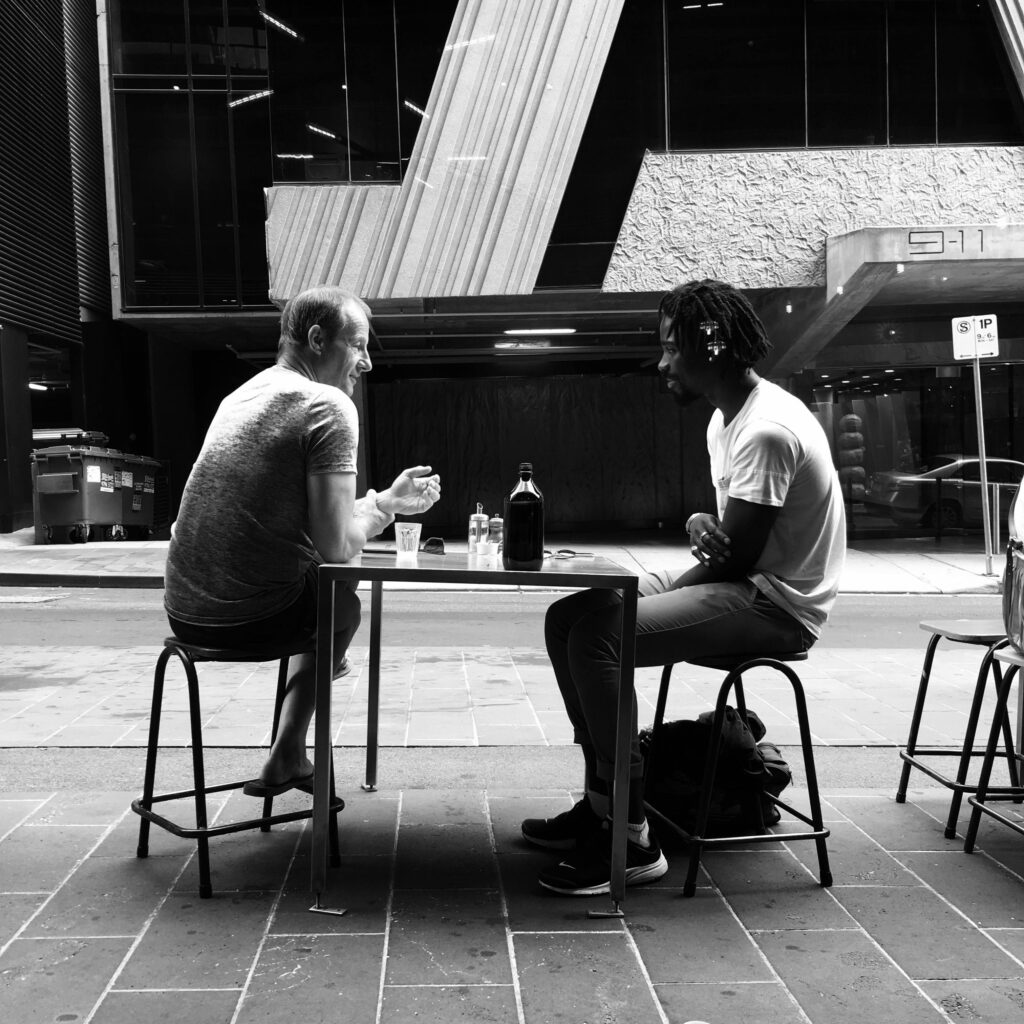Expressing Personal Struggles: The Power of Sharing

The Challenge of Opening Up Even individuals who possess a high level of emotional intelligence may find it difficult to articulate their personal struggles. The act of expressing these challenges is not always easy, regardless of one’s emotional skill set. The Benefits of Sharing Experiences Sharing our personal difficulties serves a dual purpose. Not only does it provide support and insight to others who may be experiencing similar issues, but it also offers us a valuable opportunity to reflect on and better understand our own feelings. Self-Reflection and Growth For example, writing about a tough situation at work may lead to the realization that similar challenges have been overcome in the past. This recognition can be empowering and help boost confidence as new obstacles arise. The Value of Shared Experiences If any of these experiences resonate with you, it is likely that you can draw strength from reflecting on your own journey. By sharing your story, you not only help yourself but also provide encouragement to others. In this way, both you and those around you benefit—truly a win-win situation.
Take the “I Statement” challenge

Do you ever use “I Statements”? What’s your experience with them? Helpful? Annoying? Something else? “I-Statements” are a communication strategy for bringing up a concern or addressing a conflict with another. They typically follow this fill-in-the-blank format: I feel _____________When you _____________Because _____________I would like _____________ Yet, like so many communication strategies, many variables can make a simple method more complicated than meets the eye! See what you think about this “I-Statement” challenge. Three nurses are at the nurses’ station. Two are talking about a new policy and a third, Donna, is reviewing a patient’s lab results. Donna is finding it difficult to concentrate. Which is her best statement? Image by Yerson Retamal from Pixabay 1) Shhhhh, stop talking! 2) I’m frustrated with your talking. It’s hard to concentrate and I’d appreciate it if you would quiet down. Answer It depends on what the relationships are and what Donna would like them to be! If Donna has a positive history with them, #1 is probably fine. They’d likely apologize, lower their voices, and move on. If Donna doesn’t know them or there is tension among them, Donna would be wise to use an “I statement”, like #2. It would likely be perceived in a less-threatening more collaborative manner. These are important considerations in building new relationships or being more cautious when unresolved conflict may be present. An “I-Statement” encourages speakers to show ownership about a concern, want, or need. It includes identification of emotions and invites other speakers to participate in the conversation in a collaborative fashion. In short, “I Statements”, when used properly: Increase the chance of effective communication and collaboration Lead to more efficient problem-solving and conflict resolution Validate many different perspectives Build and nourish relationships Build self-awareness, self-respect, and self-efficacy They are not perfect or always effective yet, “I-Statements” are a valuable tool in building effective communication skills and collaborative relationships. Medical Improv is a teaching modality used to build communication skills and promote trusting relationships. In the high-stakes, high-stress work of healthcare professionals, interactions should be effective, respectful, and compassionate – for everyone!
Loneliness and Its Silent Toll

Life is full of twists and turns, and sometimes, it can feel like we’re navigating it all alone. Most of my greatest moments with friends have been meaningful conversations over tea or coffee. We attempt to solve every issue in our lives, kindly judging ourselves for the wrong turns we might have taken and laughing about it. Women, in particular, need this type of deep bonding to overcome life’s obstacles. True friendship is a spiritual practice. It not only keeps you dedicated and devoted to one another but grounds you as well. Women have a unique ability to create a safe space for each other—one where the other person can grow, heal, and lean on her in times of need. This kind of space enhances the self-confidence that one might lack, allowing her to feel loved by another human being. In today’s fast-paced world, it’s easy to feel isolated, even when surrounded by people. This sense of loneliness can quietly lead to depression, anxiety, and a growing sense of disconnection from the world around us. We don’t just feel it in our hearts, but in every organ of our body. When loneliness spreads throughout our physical system, every cell senses the uncertainty of not being loved or being ignored. Our stress levels rise, and over time, chronic aches and pains surface like termites quietly eating away at the foundation of our well-being. Our foundation weakens when this powerful connection is nowhere to be found. We are naturally wired to nurture and connect, and when we surround ourselves with like-minded souls, we create a web of love and support that strengthens our mental, emotional, and even physical health. When we share our stories with others, we feel heard. This act of release lightens us and brings joy, creating room for healing. The importance of celebrating each victory in our lives with a good friend cannot be overstated—it opens up more opportunities for success in the future. How many times have you thought about calling someone dear to you to share good news? How often have you planned birthday gatherings to celebrate yourself or another? All these gatherings, for one reason or another, remind us that we are here to share life experiences and feel stronger as beings. The act of sharing life with others creates a sense of belonging, which is vital for maintaining balance in our minds and hearts. Feeling understood and supported can make all the difference in how we view the world and ourselves. Friendships nourish us. Whether we connect with old friends from college or new people in our new town, we crave connection. The more people we interact with, the more our emotional hearts open to love. With all the advances in technology, it might seem that we should be able to connect more easily, but it doesn’t always feel that way. We’re getting further from one-on-one visits with friends. Talking on the phone or texting may suffice for a while, but being in each other’s presence—feeling the joy of a friend and hearing her laughter as you share a funny story—is a whole different experience. Offering a treat to your friend or sharing your culinary talent with her is a gift that technology cannot replace. While video calls and images on a screen are perfect for distant relatives and friends, for those close by, we should make the time to visit and maybe even exchange a hug to show our love. Today, I watched my two-year-old granddaughter saying hello to everyone and approaching others on the playground. This teaches us to pick up the phone and reach out to a friend, to say hello to a neighbor and exchange a few sentences, or to invite friends to a small gathering. Show up to gatherings and step out of your self-made cave to feel connected and grounded once again. Don’t let loneliness become another chronic issue in your life. We all have something to share with others that they, too, are seeking. Nameste, Shab.
Fun Improv Activities Awakens Deep Listening Skills

Simple and Profound “That’s the first time I ever felt heard”, a nurse shared during a communication workshop! My jaw dropped. I wondered how she could possibly be a good listener if she didn’t know what it was like to feel heard. It was a powerful teaching moment for me in terms of integrating improv activities into communication workshops. Image by Myriams-Fotos from Pixabay The nurse had just participated in an experiential activity I adapted from improv to teach communication and related skills. A a teacher, the nurse’s feedback was compelling. I could see how it would help her appreciate the value of truly being heard. From here, she could internalize the experience and develop awareness about listening with respect to being connected, understood, valued This skill development is much deeper than simply hearing what someone says and checking off a box. It is a door to becoming more sensitive to how and when this kind of focused listening could be helpful. Such as a patient who is nervous about a procedure, a family member becoming angry about a treatment issue, or a colleague showing signs of burnout. What’s more, her future life experiences, feedback, and leadership guidance could all be grounded back to this simple, profound experience. This contributes to a ripple effect of more awareness and skill development for the nurse and modeling for all in her circles. What is this activity? Same-Time-Story, also known as Story Mirror, involves one person telling a story while her partner tries to tell it simultaneously. Something you can only do by focusing on what your partner is saying and if s/he goes at a pace conducive to your success. You can see it here in this two-minute video from a workshop several years ago. Notice how in the middle I tap one of the participants on the shoulder, signaling the switch of leadership roles! https://www.youtube.com/watch?v=h8yj7r_C36k Other valuable feedback When facilitated properly, Medical Improv experiences like this are engaging and safe for social and emotional development. The learning is internalized as staff practice, reflect on and discuss the skills, and their application to professional communication and organizational goals. In this particular activity, participants have shared things like: “I had to focus on her and stop thinking.’ ‘Her facial expressions helped.’ ‘I realized I was speaking too fast.’ ‘You never know what is going on in someone’s head.’ ‘It was fun!” Imagine how the learning content can be framed around vital skills such as expression of nonverbal language, identifying social cues, developing awareness of speaking too fast for someone to understand and what that might feel like, and/or realizing we don’t know what others are thinking even if we think we do! When facilitated properly, Medical Improv experiences are engaging and safe for social and emotional development. The learning is internalized as staff practice, reflect on and discuss the skills, and their application to professional communication and organizational goals. With this activity, nurses, doctors, and other healthcare professionals become better prepared to listen attentively to an anxious patient, a colleague in trouble, constructive feedback from a manager, or a family member with signs of escalating anger.
A Letter of Gratitude

I came to know you at a young age, praying for my exams and wishing for the latest toys. Most of the time, it worked, and when it didn’t, I didn’t know better. Slowly, I began having conversations with you, just like two best friends. These were full-on dialogues with questions, which I probably answered myself as the issues were analyzed in my head. I just remember feeling better at the end of it, leaving me in peace and contentment. As I grew older, I learned to listen more instead of trying to talk to you directly. I began waiting for messages in different forms, and each time, my senses directed me to the right message. This became my way of finding guidance in life. Instead of seeking answers outside of myself, my inner voice—my intuition—nudged me in the right direction. This inner gift would leave me with either a sense of calmness or uneasiness about the issue at hand. That’s how I knew whether the choice was right for me or not. Meanwhile, the ups and downs of life became more challenging over time. Yet, I never lost touch with you. I always felt connected, even when every sign seemed to invite doubt. This sense of oneness was the one thing that felt stable and unchangeable in the Universe. Your presence meant so much to me. Whenever I felt disappointed in humans, I knew you would be there for me. In the past, I have asked you for the impossible, and you delivered. You have asked me for the impossible, but you gave me the courage to face it, and I was able to deliver. Our dialogues evolved into pure silence, and the answers came from within me. My alignment with the Universe and everything around me grew stronger, and you still stood by me, guiding and supervising. You heard my wishes without me even expressing them out loud. You healed my wounds and hurt before they could begin. Now, you are as close to me as my heart itself. Inseparable, I feel. You have laid a solid foundation for me to trust you in any situation. My doubts began doubting themselves. My worries could no longer rush in uninvited. My wishes became centered on closeness to you and on deepening my trust in you. I no longer yearned for things but rather for a stronger, deeper connection with you. I am writing this letter to express my gratitude for your presence in my life. Thank you for all you have shown me and for all you will continue to reveal in the future. I am practicing staying still and quieting my mind to hear your voice resonate throughout my entire being. Thank you for bringing your awareness not only to me but also to everyone I have the chance to touch and heal with your presence. Despite all the noise out there, I am listening. Your guidance is deeply appreciated. Truly yours, Shab
Finding Balance in Modern Healthcare

For over thirty years, I worked as a healthcare professional and radiation therapist in the Bay Area, California. When I first started, writing in a patient’s chart required a pencil—yes, a pencil. We used white-font pencils to meticulously fit all the necessary information onto the treatment sheet in a hard-paper chart. These charts were filed in drawers and bookshelves, a far cry from today’s digital systems. A decade later, computers began revolutionizing healthcare. They offered significant advancements but also caused chaos whenever they went down. Despite the challenges of adapting to machines, we humans managed to persevere and gradually witnessed how technology surpassed our abilities. In school, I learned to calculate treatment plans by hand, relying heavily on memory and manual computations. Fast forward two decades and students graduating from radiation therapy programs no longer need to perform complex calculations; the software does it for them. The human brain’s role has shifted dramatically. In just one department I worked in, three different types of treatment software were introduced within ten years. While some upgrades offered marginal differences, software companies excelled at marketing their products. Medical departments purchased these programs to stay competitive and attract more patients, even when the actual benefits were minimal. The Rapid Pace of Change The relentless pace of technological advancements created a growing gap between my generation and the newer one. Now that I’ve stepped away from the fast-moving life of healthcare, I still find myself wrestling with the same dilemma: Where do we draw the line to ensure machines don’t completely take over, dehumanizing our lives? At large medical establishments, I’m often given the option to check in for appointments via my phone. If I decline, I’m greeted by a kiosk that processes payments and checks me in without any human interaction. Over the years, I’ve noticed fewer people in waiting rooms, fewer receptionists welcoming patients, and more machines replacing human roles. The Human Touch I don’t know about you, but I miss the personal touch. I miss conversations with the person behind the desk who might offer an encouraging word. I miss knowing my insurance premiums were supporting a human employee. I miss the days when doctors sat across from us, engaged in genuine conversations, and truly listened, instead of focusing on their computer screens to take notes. I miss being fully examined by a physician, rather than relying solely on bloodwork or imaging results. Now, my doctor begins visits by asking for consent to record our conversation via an AI device. This shift makes me feel more anxious than before because so much of the human care I once relied on has been lost in translation between humans and machines. In the past, my doctor and I would exchange personal stories, fostering a connection that went beyond the clinical. I’d leave feeling cared for, understood, and connected to a human member of my medical team—not just a series of machines. Reclaiming Human Connection Next time you visit a doctor, take a moment to notice how important it is to connect with another person. Whether it’s a patient, a receptionist, or the physician, human rapport matters. Take the time to say hello, smile, or greet someone who might need a moment of connection. These small gestures remind us that while technology has its place, it should never replace the essence of human care. Namaste, Shab
Confronting a New Crisis

The news of my father’s Stage 4 lymphoma diagnosis was a devastating blow to our family. Just as we had begun to breathe easier, hoping that our recent struggles were behind us, we were thrust into a new and frightening chapter. This diagnosis, more severe than anything we had faced before, cast a shadow over the small victories we had celebrated in his recovery from Transverse Myelitis. The intensity of the new challenge was overwhelming. As the gravity of the situation sank in, the daily demands of caregiving surged to new heights. Coordinating his treatment, managing appointments, and grappling with the complex medical information became a central focus of my life once again. The emotional weight of seeing my father face such a dire prognosis was equally heavy. The hope we had clung to seemed to slip further away with each passing day. During this period, the balance I had worked so hard to achieve in my personal and professional life was disrupted. My career, which had just begun to stabilize, now faced renewed uncertainty as I struggled to juggle the increased demands of caregiving. The stress of managing my father’s illness, coupled with the need to maintain my responsibilities at work, created an immense strain. I found myself once again grappling with the challenge of keeping my professional commitments while providing the intensive care my father required. The emotional toll was profound. The fear of losing my father, combined with the strain of navigating his complex treatment, took a significant impact on my mental health. Even though I had learned to cope with stress through exercise and a focus on self-care, this new crisis tested my limits. The once-clear boundaries between work, caregiving, and personal life began to blur, and I felt as though I was caught in an unrelenting cycle of worry and exhaustion. Despite the overwhelming circumstances, I leaned heavily on the support systems around me. My brother continued to play a crucial role in managing my father’s care and providing emotional support. His steadfast presence was a source of comfort and stability amidst the chaos. Additionally, the resilience I had developed during previous challenges became a vital resource. Drawing on the strength and coping strategies I had cultivated, I faced this new crisis with a determined resolve, even as I struggled to find a new equilibrium. The journey with my father’s lymphoma was a harsh reminder of the unpredictability of life. Just when we thought we had found a semblance of normalcy, we were faced with a renewed struggle. Each day brought its own set of challenges and uncertainties, and the path forward was fraught with difficulty. Yet, even in the face of this daunting reality, I remained committed to navigating this tumultuous period with as much grace and resilience as I could muster. As we moved forward, the hope that had once seemed so tangible was now intertwined with the reality of ongoing battles. While the road ahead was daunting, I found solace in the strength of my support system and the determination to provide the best care for my father. The journey was far from over, but each step was taken with the hope that we could find moments of peace and clarity amid the ongoing struggles.
A Hopeful Recovery and Life’s Balancing Act

As my father’s health improved from his battle with Transverse Myelitis, our family began to feel a glimmer of hope. After enduring years of medical crises and caregiving demands, we cautiously believed that this would be the last major health issue he would face. His gradual recovery provided a sense of optimism and a much-needed respite from the relentless pressures that had dominated our lives. With my father’s condition stabilizing, I found myself trying to regain a sense of normalcy. Reengaging with my career became a priority, and I was determined to restore balance to my life. My daughter’s growing independence offered me some flexibility, allowing me to invest more time and energy into my work. It was both challenging and relieving to refocus on my career, as it provided me with a renewed sense of purpose and control after years of managing the chaotic demands of caregiving and single parenthood. At home, I worked diligently to strike a balance between my professional responsibilities and my father’s ongoing care. My brother, a dedicated high school math teacher, emerged as an instrumental support system during this period. His assistance with my father’s care was invaluable, and his emotional support helped anchor me amidst the ongoing challenges. His presence offered much-needed relief and comfort, and I was deeply grateful for his unwavering support during these trying times. In addition to focusing on my father’s care, I also prioritized my own well-being. Exercise became a crucial outlet for managing stress and maintaining my mental health. It was more than just a physical activity; it served as a vital escape and a way to recharge. This routine helped me stay resilient and better equipped to handle the demands of my daily life. As life began to stabilize, I dared to envision a future where we could enjoy a semblance of normalcy once again. My daughter was thriving, my career was back on track, and my father’s recovery was progressing positively. For the first time in years, it felt as though we might finally experience some relief and stability after enduring so much. However, just as I started to believe that the worst was behind us, we were hit with devastating news: my father was diagnosed with Stage 4 lymphoma. The unexpected diagnosis was a crushing blow, shattering the fragile sense of stability we had worked so hard to rebuild. This new challenge set us on yet another tumultuous path, testing the resilience and strength that I had painstakingly developed over the years. The journey ahead was uncertain, but it was clear that our trials were far from over.
Dreams of a Bright Future

A Serendipitous Meeting I met my husband at work, an encounter that seemed serendipitous and filled with promise. We were both driven and passionate about our careers, but there was an undeniable connection that drew us together. Our courtship was a blend of professional respect and personal affection, culminating in a beautiful wedding surrounded by friends and family. A Historic Wedding Our wedding was not only beautiful but also historic. We got married six days after 9/11 in the tallest building in San Francisco. The world was reeling from the recent tragedy, and our ceremony became a symbol of hope and resilience. Despite the sorrow and uncertainty that permeated the atmosphere, our love shone brightly, bringing a moment of joy and unity to those who attended. Building a Home Together We bought our first home in downtown San Jose, envisioning it as a vibrant hub where we could explore all that a lively downtown had to offer. Weekends became adventures filled with motorcycle rides through winding coastal roads, exhilarating skydives, laughter-filled gatherings with friends, visits to family, and taking full advantage of the Bay Area’s cultural and recreational riches. The Joy of Parenthood The day I found out I was pregnant was one of the happiest moments of my life. The anticipation of welcoming our daughter into the world brought a new sense of purpose and joy. We meticulously prepared for her arrival, transforming a spare room into a charming nursery and attending parenting classes to ensure we were ready for this new chapter. Hopes and Aspirations With the arrival of our daughter, our dreams expanded. We envisioned a future where she would thrive, supported by our love and the opportunities of the Bay Area. We dreamed of providing her with the best education, exposing her to diverse cultures, and watching her grow into a strong, independent individual. Our aspirations for a bright future were boundless. Navigating Early Parenthood The early days of parenthood were a mix of exhaustion and exhilaration. Sleepless nights and constant diaper changes were balanced by the joy of seeing our daughter’s first smile and hearing her first laugh. Despite the challenges, the bond we shared as a family grew stronger with each passing day. Balancing Work and Family Balancing our demanding careers with the responsibilities of parenthood was a delicate act. We took turns attending to nighttime feedings and worked out a schedule that allowed us to be present for our daughter while advancing in our respective fields. The support of our workplace policies on parental leave and flexible hours played a crucial role in maintaining this balance. Community Support The support of our friends and family was invaluable. We became part of a close-knit community of new parents, sharing tips, organizing playdates, and offering each other moral support. The sense of belonging and shared experience helped us navigate the early challenges of parenthood. Future Plans The support of our friends and family was invaluable. We became part of a close-knit community of new parents, sharing tips, organizing playdates, and offering each other moral support. The sense of belonging and shared experience helped us navigate the early challenges of parenthood.
Finding the Perfect Age for Solo Halloween Adventures

The decision of when kids should be allowed to trick or treat without an adult is a matter of judgment that depends on various factors. Here are some key considerations to help you determine if your child is ready to go trick-or-treating without adult supervision: Age: The general consensus is that around the age of 12 is an appropriate time to let kids trick-or-treat alone. However, every child is different, and some may be ready earlier, while others might need more time. Safety Concerns: Consider the safety concerns in your neighborhood. Are there sidewalks, streetlights, and low traffic? If your area has limited visibility and high traffic, it might be safer for kids to be accompanied by an adult. Visibility: Make sure your child is easily visible to drivers and other pedestrians. Use flashlights, glow sticks, reflective tape, and other visible accessories to ensure they can be seen in the dark. Costume Safety: Ensure that your child’s costume is safe and doesn’t pose a tripping or falling hazard. Choose flame-resistant fabrics and comfortable shoes to prevent injuries. Practice Run: Take a practice run with your child before Halloween night to familiarize them with the route, streetlights, and safe street crossings. Set a curfew for their return. Communication: Both you and your child should have a way to communicate. Consider giving them a cell phone or a smartwatch, but remind them to be mindful of their surroundings and not get too distracted by technology. Safety in Numbers: Encourage your child to go trick-or-treating with a group of friends or siblings, as being in a group can enhance safety. Knowing the Area: Make sure your child knows the area and the neighborhood. Teach them to only visit houses with their outside lights on and to never enter anyone’s home, yard, or car. Developmental Age: Consider your child’s developmental age, not just their chronological age. Some children may know the area but might not be developmentally mature enough to make decisions in challenging situations. Safety Concepts: Discuss basic personal safety concepts with your child, such as how to deal with “tricky people” and when to call for help. Have a code word or emoji they can use to signal if they need assistance. Ultimately, the decision should be based on your child’s individual readiness and your comfort level as a parent. You can also take gradual steps to increase their independence, such as allowing them to visit houses while you remain on the sidewalk or only letting them trick-or-treat on one side of the street until they are more comfortable. Safety is paramount, so ensure that your child is well-prepared and understands the rules and expectations before going out on Halloween night.
